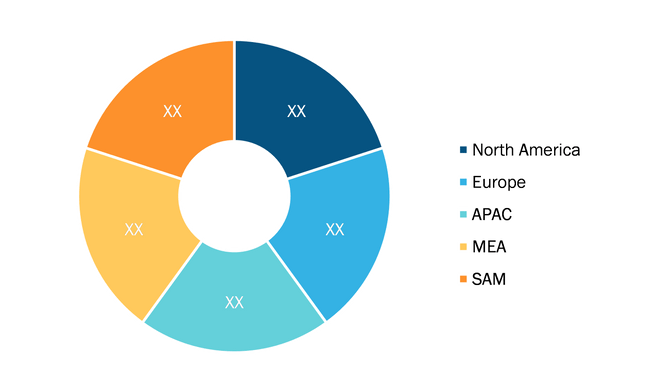Deployment of Electronic Warfare Systems on Unmanned Vehicles to Drive Electronic Warfare Market Growth During 2021–2028
According to our latest market study on “Electronic Warfare Market Forecast to 2028 – COVID-19 Impact and Global Analysis – by Component, Application, and Product Type,” the market is expected to grow from US$ 18,192.85 million in 2021 to US$ 27,797.72 million by 2028. It is estimated to grow at a CAGR of 6.2% from 2021 to 2028.
Armed forces and non-state groups employ unmanned aerial systems. Finding strategies to defeat the weaponized drones as their use spreads across the battlefield is a top issue. As a result of these advantages, countries including the US, India, and China plan to purchase and deploy additional UAVs in their military forces. Such initiatives by these governments are supporting the growth of the electronic warfare market.
Electronic Warfare Market Share – by Region, 2020

Electronic Warfare Market Growth Report and Size by 2031
Download Free Sample
Electronic Warfare Market Size and Forecast (2021 - 2031), Global and Regional Share, Trend, and Growth Opportunity Analysis Report Coverage: By Component (Hardware, Software, and Services), Application (Electronic Attack, Electronic Protection, and Electronic Warfare Support), Product Type (Countermeasure Systems, Jammers, Sensor Systems, Weapons Systems, and Others), and Geography
Electronic Warfare Market Growth Report and Size by 2031
Download Free SampleElectronic Warfare Market Size and Forecast (2021 - 2031), Global and Regional Share, Trend, and Growth Opportunity Analysis Report Coverage: By Component (Hardware, Software, and Services), Application (Electronic Attack, Electronic Protection, and Electronic Warfare Support), Product Type (Countermeasure Systems, Jammers, Sensor Systems, Weapons Systems, and Others), and Geography
Turkey is the world's second-biggest drone striker, after the US, and the world's largest manufacturer of unmanned aerial vehicles (UAVs). In November 2020, Aselsan, a Turkish defense company, created and manufactured KORAL, a land-based radar EW system. As the procurement of unmanned vehicles is increasing, it is also augmenting the growth of the electronic warfare systems market.
Impact of COVID-19 Pandemic on Electronic Warfare Market Growth
The onset of the COVID-19 crisis has posed numerous challenges and hampered the business dynamics. Many developing and developed countries' governments have limited their defense budgets which in turn has slowed down the growth of the market. However, the rising geographical tension between neighboring countries has led many governments to invest massive capital in their defense budget positively impacting the market. Government rising inclinations towards enhancing defense security created lucrative opportunities for the key vendors operating in the electronic warfare market. Thus, with the rising defense budgets worldwide, the market is showing a northwards direction of growth. For instance, on 28 March 2022, the US government announced the defense budget for the fiscal year 2023. According to it, the country is investing US$ 773 billion, which is a 4.1% increase from the fiscal year 2022.
India, China, South Korea, and Japan countries in APAC invest huge resources in military operations, which allows them to deploy advanced systems and technologies, including electronic warfare systems. Furthermore, China, India, Japan, South Korea, and Australia allocated US$ 252.3 billion, US$ 72.8 billion, US$ 49.1 billion, US$ 45.7 billion, and US$ 27.5 billion, respectively, in 2020, to strengthen their military operations. Asian countries are expected to witness a rise in the penetration of electronic warfare products in the coming years due to the ongoing territorial disputes between several Southeast Asian countries and China. Thus, ongoing territorial disputes between APAC countries has created lucrative opportunities for the key vendors operating in electronic warfare market.
According to SIPRI, South Africa and Saudi Arabia invested US$ 3.1 billion and US$ 57.5 billion, respectively, in efforts to strengthen their military forces in 2020. This is augmenting the growth of the electronic warfare market in the region.
Lockheed Martin is a leading company in the electronic warfare market. It focuses on accelerating the cash of its supply chain partners and small critical suppliers. In 2021, the company received US$ 1.1 billion from the US. The Department of Defense (DOD) and the company have flowed down to its suppliers, i.e., accelerated payments to supply chain partners. As a result, this has accelerated cash to risk suppliers and small businesses has positively impacted the growth of the electronic warfare market.
The key players operating in the market are Lockheed Martin Corporation, Raytheon Technologies, L3Harris Corporation, Northrop Grumman Corporation, and BAE Systems Plc. Several important market players were analyzed during this study to get a holistic view of the market and its ecosystem.
The electronic warfare market is analyzed on the basis of component, application, product type, and geography. Based on component, the market is segmented into hardware, software, and services. By application, the market is segmented into electronic attack, electronic protection, and electronic warfare support. Based on product type, the market is segmented into countermeasure systems, jammers, sensor systems, weapons systems, and others. Based on geography, the electronic warfare market is primarily segmented into North America, Europe, Asia Pacific (APAC), the Middle East & Africa (MEA), and South America
Contact Us
Phone: +1-646-491-9876
Email Id: sales@theinsightpartners.com